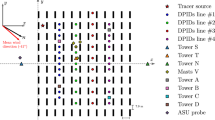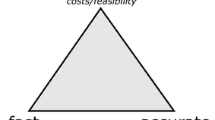Abstract
The estimation of short-term-averaged maximum concentration is of foremost importance, for instance, for the impact assessment of odorant sources, flammable gases and the accidental or intentional release of toxic gases. As dispersion models only give 1-h averaged concentration values, a simple formulation (the power-law function) has been widely used in practical applications to overcome this limitation. The present study investigates the potential of large-eddy simulation (LES) to assess the influence of turbulent eddies on averaged concentration over short time intervals and, thus, on dispersion within a building array, with LES results compared with wind-tunnel data. The results indicate that the LES approach underpredicts the concentration fluctuation intensities governed by the smaller eddy motions and we conclude, not surprisingly, that the particular choice of subgrid-scale model and grid size is important in describing the smallest wavelength concentration motions. However, even though the LES results are not able to predict peak-to-mean values for very short averaging times, the fit of the power-law function can be extrapolated to produce a valid relation for shorter averaging times, implying the LES technique can be used to assess the p value (the exponent) in the commonly-used power-law function. This is found to be smaller (by about one half) for sensors in the central position within the array than for those located in short streets or at intersections, and it also decreases more slowly with distance from the source. No substantial difference is found between sensors located at the canopy height H and at half the canopy height, i.e. within the canopy. In contrast, there is a significant difference for sensors located above the building height at 1.5H.






Similar content being viewed by others
References
Barry PJ (1971) A note on peak-to-mean concentration ratios. Boundary-Layer Meteorol 2:122–126
Bartzis JG, Sfetsos A, Andronopoulos S (2008) On the individual exposure from airborne hazardous releases: the effect of atmospheric turbulence. J Hazard Mater A 150:76–82
Bartzis JG, Efthimiou GC, Andronopoulos S (2015) Modelling short term individual exposure from airborne hazardous releases in urban environments. J Hazard Mater A 300:182–188
Castro IP, Xie ZT, Fuka V, Robins AR, Carpentieri M, Hayden P, Hertwig D, Coceal O (2017) Measurements and computations of flow in an urban street system. Boundary-Layer Meterorol 162:207–230
Cimorelli AJ, Perry SG, Venkatram A, Weil JC, Paine RJ, Wilson RB, Lee RF, Peters WD, Brode RW (2005) AERMOD: a dispersion model for industrial source applications. Part I: General model formulation and boundary-layer characterization. J Appl Meteorol 44(5):682–693
Dairay T, Lamballais E, Laizet S, Vassilicos JC (2017) Numerical dissipation vs. subgrid-scale modelling for large eddy simulation. J Comput Phys 337:252–274
De Melo AMV, Santos JM, Mavroidis I, Reis NC Jr (2012) Modelling of odour dispersion around a pig farm building complex using AERMOD and CALPUFF. Comparison with wind-tunnel results. Build Environ 56:8–20
Dourado H, Santos JM, Reis NC Jr, Melo AMV (2012) The effects of atmospheric turbulence on peak-to-mean concentration ratio and its consequence on the odour impact assessment using dispersion models. Chem Eng Trans 30:163–168
Dourado H, Santos JM, Reis NC Jr, Mavroidis I (2014) Development of a fluctuating plume model for odour dispersion around buildings. Atmos Environ 89:148–157
Efthimiou GC, Bartzis JG (2011) Atmospheric dispersion and individual exposure of hazardous materials. J Hazard Mater A 188:375–383
Efthimiou GC, Bartzis JG, Berbekar E, Hertwig D, Harms F, Leitl B (2015) Modelling short-term maximum individual exposure from airborne hazardous releases in urban environments. Part ΙI: validation of a deterministic model with wind-tunnel experimental data. Toxics 3:259–267
Efthimiou GC, Andronopoulos S, Bartzis JG (2017) Prediction of dosage-based parameters from the puff dispersion of airborne materials in urban environments using the CFD-RANS methodology. Meteorol Atmos Phys 130(1):107–124
Fuka V, Xie ZT, Castro IP, Hayden P, Carpentieri M, Robins AG (2017) Scalar fluxes near a tall building in an aligned array of rectangular buildings. Boundary-Layer Meteorol 167(1):53–76
Germano M, Piomelli U, Moin P, Cabot WH (1991) A dynamic subgrid-scale eddy viscosity model. Phys Fluids A – Fluid Dyn 3(7):1760–1765
Gifford FA (1960) Peak to average concentration ratios according to a fluctuating plume dispersion model. Int J Air Pollut 3:253–260
Hinds WT (1969) Peak-to-mean concentration ratios from ground-level sources in building wakes. Atmos Environ 3:145–156
Inagaki M, Kondoh T, Nagano Y (2005) A mixed-time-scale SGS model with fixed model parameters for practical LES. J Fluids Eng 127:1–13
Liu XP, Niu JL, Kwok KCS (2011) Analysis of concentration fluctuations in gas dispersion around high-rise building for different incident wind directions. J Hazard Mater A 192:1623–1632
Mavroidis I (2009) Effect of averaging time on mean concentrations in building influenced dispersion. Int J Environ Waste Manag 4(1/2):50–61
Mole N, Andersen CW, Nadarajah S, Wright C (1995) A generalized Pareto distribution model for high concentration in short range atmospheric dispersion. Environmentrics 6:595–606
Munro RJ, Chatwin PC, Mole N (2001) The high concentration tails of the probability density function of a dispersion scalar in the atmosphere. Boundary-Layer Meteorol 98:315–339
Nicoud F, Ducros F (1999) Subgrid-scale stress modelling based on the square of the velocity gradient tensor. Flow Turbul Combust 62(3):183–200
Piringer M, Knauder W, Petz E, Schauberger G (2014) Site-dependent decrease of odour-related peak-to-mean factors with distance. Adv Sci Res 11:69–73
Ramsdell JV Jr, Hinds WT (1971) Concentration fluctuation and peak-to-mean concentration ratios in plumes from a ground-level continuous point source. Atmos Environ 5:483–495
Santos JM, Griffiths RF, Reis NC Jr., Mavroidis I (2009) Experimental investigation of averaging time effects on building influenced atmospheric dispersion under different meteorological stability conditions. Build Environ 44:1295–1305
Schauberger G, Piringer M, Schmitzer R, Kamp M, Sowa A, Koch R, Eckhof W, Grimm E, Kypke J, Hartung E (2012) Concept to assess the human perception of odour by estimating short-time peak concentrations from one-hour mean values. Reply to a comment by Janicke et al. Atmos Environ 54:624–628
Scire JS, Strimaitis DG, Yamartino RJ (2000) An user’s guide for the CALPUFF dispersion model (version 5). Prepared for the California Air Resources Board by Sigma Research Corporation from Earth Tech Inc., Concord, MA, USA
Seinfeld JH (1986) Atmospheric chemistry and physics of air pollution. Wiley, New York
Singer IA (1961) The relationship between peak and mean concentrations. J Air Pollut Control Assoc 11(7):336–341
Singer IA, Imai K, Del Campo RG (1963) Peak-to-mean pollutant concentration ratios for various terrain and vegetation cover. J Air Pollut Control Assoc 13(1):40–42
Smith ME (1973) Recommended guide for the prediction of the dispersion of airborne effluents. New York
Tejada-Martínez AE, Jansen KE (2004) A dynamic Smagorinsky model with dynamic determination of the filter width ratio. Phys Fluids 16(7):2514
Xie ZT (2011) Modelling street-scale flow and dispersion in realistic winds—towards coupling with mesoscale meteorological models. Boundary-Layer Meteorol 141:53–75
Xie ZT, Hayden P, Voke PR, Robins AR (2004) Large-eddy simulation of dispersion: comparison between elevated and ground-level sources. J Turbul 5:0–31
Xie ZT, Hayden P, Robins AG, Voke PR (2007) Modelling extreme concentrations from a source in a turbulent flow over a rough wall. Atmos Environ 41(2007):3395–3406
Acknowledgements
This work was supported by the Newton Research Collaboration Programme Award NRCP1617-6-140 administered by the Royal Academy of Engineering as part of the UK Government’s Newton Fund. The study was also financed in part by the Coordenação de Aperfeiçoamento de Pessoal de Nível Superior - Brasil (CAPES) - Finance Code 001 and Fundação Amparo à Pesquisa do Espírito Santo (FAPES). JMS thanks the EnFlo team, University of Surrey, for providing the wind-tunnel data through https://doi.org/10.6084/m9.figshare.5297245.
Author information
Authors and Affiliations
Corresponding author
Additional information
Publisher’s Note
Springer Nature remains neutral with regard to jurisdictional claims in published maps and institutional affiliations.
Rights and permissions
About this article
Cite this article
Santos, J.M., Reis, N.C., Castro, I.P. et al. Using Large-Eddy Simulation and Wind-Tunnel Data to Investigate Peak-to-Mean Concentration Ratios in an Urban Environment. Boundary-Layer Meteorol 172, 333–350 (2019). https://doi.org/10.1007/s10546-019-00448-1
Received:
Accepted:
Published:
Issue Date:
DOI: https://doi.org/10.1007/s10546-019-00448-1




